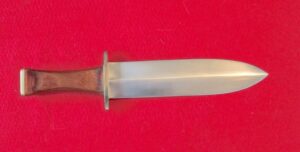
By Jim Dickson | Contributing editor
Men have been fighting with knives for as long as there have been knives with which to fight.
Any knife that works for cutting up game will also work for cutting up people. This was one of man’s earliest discoveries and one that he has put to work tirelessly ever since.
Today’s man is often so far removed from the daily reality of combat with edged weapons that his forbearers knew that his view of fighting knives is often shaped by what an artist draws in comic books. There is always some maker willing to make his fantasy creation even if it has no basis in practical reality.
The worst offenders are saw teeth and hollow handles for “Survival kits.” The true survival kit fills an army backpack. It is not what fills a pill bottle size space in a knife handle. These handles often break off except for one that I saw that was machined out of a bar of solid steel. You were still stuck with a piece of pipe for a handle which is a very bad design ergonomically for its intended purpose.
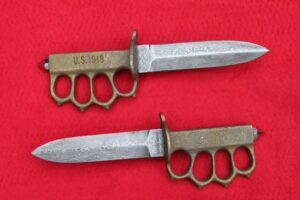
At the base of every saw tooth you have a sharp angle that acts as a stress riser just like the groove a glass cutter makes in a piece of glass. Put stress on the blade and it concentrates there and if there is enough stress that’s where it will break. The U.S. Army almost never had broken bayonets until they made some with saw teeth and then they had bushels of them coming back.
Shapes of these fantasy based knives get downright weird at times. A knife is a basic tool and weapon and the traditional shapes got to be traditional because they are what works. Every imaginable shape has been tried over the years and the useless ones quickly discarded only to be regularly resurrected as something “New and different” before being discarded again.
Smaller Models
Starting with the small light knives such as straight razors, folding knives, and British commando dagger sized blades we run into a problem as these light blades have trouble cutting through thick clothing and a coat wrapped around an arm has often proved an effective shield against these light blades.
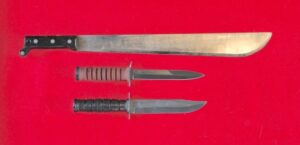
The British commando dagger is also notorious for breaking at its thin point, so much so that American OSS agents took to breaking or grinding it off and sharpening a stouter point. It eventually was replaced in U.S. Service with the much stouter MK3 trench knife which had none of the British knife’s faults. This is a traditional shaped blade that a Scotsman will immediately recognize as a spear pointed deerstalkers graloching knife, with a stout narrow blade for making the fine cuts when dressing a deer carcass.
The MK3 brings us to the medium size fighting knives with 6 to 8 inch blades. The Marine Corps went with the Kabar, which was the same 7-inch length as the MK3 but with a wider blade that was harder to jab through an enemy’s rib cage. The U.S. Army’s WW1 brass knuckle hilted MK1 fighting knife is definitely the deadliest of the knives in this category. It’s well designed brass knuckle handle is easily used in every style of knife grip and there is no way that this knife is going to be knocked out of your hand or dropped. While I regard the original double edged blade as a bit on the light side replacing it with a heavier double edged blade is easily done and with one of these in each hand you have a really dangerous close quarters combat knife set.
Larger Versions
Moving up to the 9 inch and larger blades we begin to see knives with wood chopping ability. A knife that is good for serious wood cutting will also take a man’s arm off with one stroke. This is where smaller and lighter knives fail. Don’t think that isn’t important in a life or death struggle. The longer blades give a serious reach advantage that is decisive in expert hands. Longer is better. A Kabar is no match for a machete.
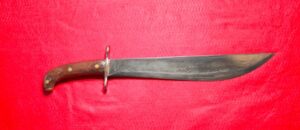
In this category you find large Bowie knives, Gurkha kukris, Philippine bolo knives, and machetes. Don’t let anyone tell you that a light British commando dagger is faster. These big wood cutting knives are designed for speed. Take a look at the giant Confederate side knife with the knucklebow in the photo. That is actually one of the fastest knives I have ever used. Like many edged weapons it wants to be wielded in a certain way but once you do that it struts its stuff like no other.
What most folks don’t realize is that weight can actually increase speed and maneuverability if it is properly employed. This is easy to do with a well-balanced lively design. Not so easy with a poorly designed piece that feels like just a bar of iron in your hand.
None of the good examples of fighting knives fail as general purpose work, hunting, and survival knives. The knife is man’s most basic tool and fighting man or beast is part of its basic job description. A good knife will do all things a knife of its size can do and do them well. “Looking mean” is not part of the basic job description.
A lot of big butcher and slicing knives have ended up as fighting knives over the years even though they don’t look the part. I have an old beat up long butcher’s slicing knife that is scarred from many a blade encounter which left cut grooves in its sides from where it parried the other blade. It’s not much to look at but it’s been and done as they say. It still works just fine for heavy duty butchering work on cows.
Important Features
There are some desirable features to have in a fighting knife.
A double guard offers some protection to the hand from another knife but offers more protection from the hand slipping down on the blade and getting cut. This is really important on a hard thrust. When doing heavy cutting you can shove the hand against the top guard to get more leverage in cutting when you need it. I like a double guard on all my personal hunting and working knives.
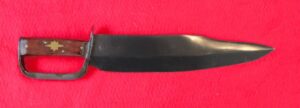
A double edged blade is extremely desirable as you can cut coming and going without having to take time to twist your wrist and arm. Heavy wide bladed double edged knives were the preferred design of the North American Indians for their own all-purpose knives. The Hudson’s Bay Dag knife was a big 10-inch-long by 2 ¼-inch-wide double edged blade. This was a favorite all-purpose knife of the Canadian Indians up to the early 20th Century. You would be hard pressed to match their wilderness skills today so their preference for an all-purpose blade design deserves great respect.
The first Bowie knives were used for fighting with the edge up and the back of the blade down. You stepped in and struck the enemy’s blade aside with the back of your blade and if you had a chance to slash instead of thrust you did it with the sharpened top edge as a claw.
Knives made for this style of fighting often had the handle angled up instead of down. Sometimes a brass parry strip was put on the back of the blade as a shock absorber to reassure the customer that his knife would not break in the violent clash of blades. It was never intended to catch the edge of the enemy’s blade as some modern writers claimed. If they had only tried it, they would have quickly seen that it can’t work that way.
Some of these early Bowies were definitely made by James Black, credited with making the final knife that Jim Bowie carried. Even if the Bowie knife is gripped as a saber it still needs the false edge sharpened.
The blade needs to be reasonably thick to the stress and shock of combat use. Really thin blades have been known to bend and even break on a rib so try not to use a fillet knife or your average thin bladed kitchen knife for serious work.
Saw teeth can not only cause a blade to break starting at the bottom of a tooth. They can also snag going in and out especially if they encounter heavy clothing. This can result in a fatal delay in a knife fight where a rolled up coat on the arm is often employed as a makeshift shield or simply loose clothing catching in the saw teeth during a slash or thrust. This is critical in a knife fight because you have to stay one step out of reach of your opponent only moving in to attack and then out again before he can respond. If your blade catches, a knife fighter would be in trouble.
Also, if your knife has cutouts in the blade for style then I would not trust it. Cutouts have no place on a blade and a knife designed for looks and style is not a knife designed for real world encounters. Holes are what you put in the enemy, not your knife blade. Get a conservative traditional design that has stood the test of time.



